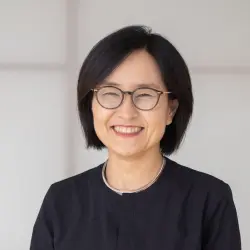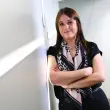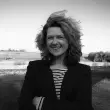Your Interview Kaori Umeda

Kaori Umeda
Designer, Educator
Japan
Introduce yourself (name, company, position, country) and tell us how you got into lighting design (including education/qualifications).
My name is Kaori Umeda. I run a lighting design studio named "Studio LUME," and I am a lighting designer. I don't have permanent staff, but I ask designers I know to help me out depending on the situation.
My father was an architect, and he'd taken me to the site since I was little. I loved looking at architecture books, and I came to love architecture. I was interested in working in the architecture industry, but I didn't feel like working with my father.
When I was in high school, I found out that there was a study field called industrial design. Since I loved art and math, I thought this would be a good fit for me. I majored in industrial design in the Faculty of Engineering at university and learned a wide range of manufacturing, from engineering to design and art.
Still, I wanted to design spaces rather than products.
When I was in my second year of college, I went on a trip to the U.S. with my friend. We walked into a used bookstore by chance, and I picked up a book called "The Lighting Book," which was an educational book on residential lighting design. It covered information on the principles of light, the characteristics of fixtures, light distribution planning, and even electrical work. After reading this book, I developed a keen interest in lighting. My perspective on light changed and came to see the light as a part of the material of architecture.
I was working part-time at an architectural design office when I start looking for a job. One day I told the people there that I was interested in lighting. They recommended applying for Yamagiwa's TL Laboratory. After that, I was fortunate enough to be hired by Yamagiwa, and that's how I entered the lighting design business.
If I hadn't come across that book in the U.S., my life might have been different!
I worked at Yamagiwa for about eight years in the design department and the product development department. It was the end of the bubble economy, and I engaged in a lot of exciting and significant projects. It was very fulfilling, but as I got to know the design industry, I started to feel frustrated. Because I didn't understand the background of the manufacturing process well, I couldn't fully communicate with people in the production and construction sites. To learn the process more, I studied in Finland and worked at a local facility design office for about five years. Then, my husband had to go to Sendai, Japan, for work. I returned with him. There were no lighting design companies in Sendai, so I ended up opening my studio.
Tell us about your work – is there a specific type of project you like to work on or an area you specialise in and why?
The type of projects I worked on used to be unbalanced, depending on the time. Sometimes it was housing, at other times a clinic, and so on. Recently, I've worked on a variety of projects, including housing, museums, recreation facilities, buildings, and university facilities. I don't turn down offers that come to me.
Illuminations are becoming my lifework. At Yamagiwa, there were not many projects to light-up nature, but only on a small scale, like a spot garden attached to a building. When I was in Finland, I took part in a workshop called "VALON VOIMAT (The Power of Light)." I think that experience opened my eyes to illuminations. Since the illumination of Rairaikyo Gorge in Akiu, Sendai, held in 2012, I have done continuously illumination, such as the Tenshukaku Park and temple gardens.
A lighting plan for buildings can be hypothesized by calculation, but not for nature. For example, when we illuminate the autumn leaves, the scene of the production changes as time goes by. The leaves change its color and fall in the end. The weather changes how it looks too. The shade of leaves and branches can change drastically by a slight difference in lighting you make.
I also collaborate with people in various industries and involve creators in other genres and people in the city. Illumination events don't always attract people just because the lights are beautiful. It's not only about illumination but about promotion. It's about making connections with people. It's interesting to get the reaction of the people who've seen the lighting right away, as well.
What project are you most proud of and why?
It's the residential project that I designed right after I returned to Japan from Finland. The clients were a couple who had been living under just day-white color temperature ceiling lights and had never experienced "designed light" in their life before. I presented a plan for replacing the lighting with warm-colored ones and making it possible to change the atmosphere of the room by the lights depending on the scenes like "listening-to-music". I was a little unsure if they would accept it because it was so different from the light environment they were accustomed to.
When I asked them how they were doing about a year after the completion, they told me that they had almost stopped watching TV. They were happy that the time watching TV at home had changed into the time listening to music and reading books.
Of course, I get a sense of accomplishment in a large-scale project, but I got a strong feeling that "light can change lives" on this project. I was truly glad that I did it.
What is the biggest challenge that you have overcome in your career?
One example would be a lighting workshop called "Lights In Alingsås " held in the town of Alingsås, Sweden. About a year after I returned to Japan, I was asked to become a group leader for the workshop. I wasn't sure if I should have taken the role because, at the time, I had little experience in lighting design for natural objects and got a lot of pressure to lead a group work in English, which I wasn't used to. I was reluctant to go there alone too. A former colleague of mine at Yamagiwa offered me to go with and help, so I made up my mind to accept it. The participants of my team were students from 8 different countries, and it turned out they were all excellent. They worked together very well.
How does light inspire you?
Light is something that gives me a connection to people and society.
Through the light, I have met many people, made someone happy, and expressed myself.
Through the filter of light, I feel like I can meet people who have similar values to mine. I felt this when I was in Finland, and it's not limited to the design world either. For example, I've never met a salesman selling light fixtures whom I get an unfavorable impression of. Unlike other products, light has no substance and difficult to sell. However, those who dare to choose the difficult "light" as a profession are the ones who understand what makes them happy. I don't think they are bad people.
What is your message for other Women In Lighting?
I think there are things you don't notice unless you're a woman, and there are things you can't do unless you're a woman. However, things can be decided without those viewpoints because there aren't women in decision-making positions. It would be great if we can consider these problems more and make them better through activities such as Women In Lighting.
Light gives people positive power, both psychologically and physically. Let's give them the power through light, and enjoy our lives as well.
–
Interviewed by Lyshus; Translated by Akane H
“Let’s give people the power through light, and enjoy our lives as well.”
Selected portfolio:
_1_-_28de80_-_9c15f262bb102a6122ba85fecd9ac1151a5d26d6.webp)
_1_-_28de80_-_e4e203b0a549d9314c40537eb459b919cedb5d64.webp)
_1_-_28de80_-_312848bd09aef3bd5e181195c56e4440a0bc6fa5.webp)
_1_-_28de80_-_62bd050d975708bfb73de814aa9bc3f4dbef62d3.webp)
_1_-_28de80_-_5c2394ceec12b66f5890ef85637b708eb7145994.webp)

_-_28de80_-_8361d044d2edec1980f143c24d13d209c3de6258.webp)


